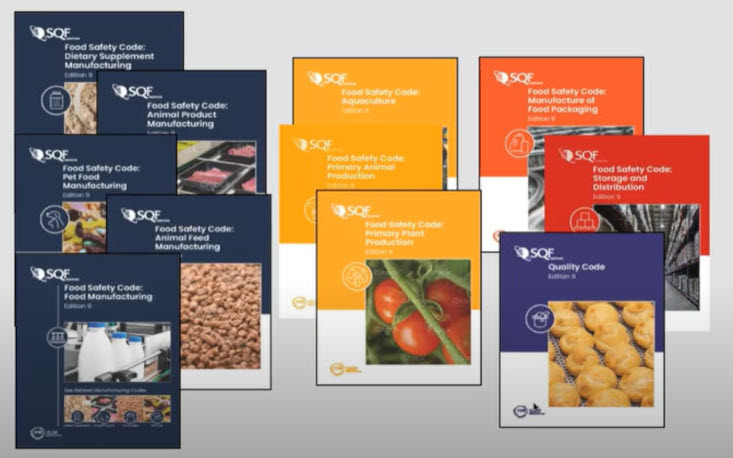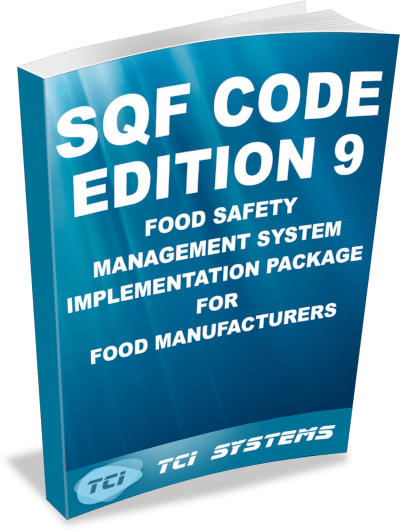SQF Edition 9 Changes: New Design and Technical Improvements
The SQF Code Edition 9 comes with a new layout and design for those technical changes. With the SQF Edition 9 changes here, this image below outlines the different codes that we have implemented now. The primary production code as you can see is now broken up into three different codes. The primary production code was all under one code, it had one system element with various modules behind it but the Edition 9 code now has three different codes. One for animal, one for plant and another one for aquaculture. That means that there’s different system elements for those industry sectors specifically that address those risks for that industry sector and that’s what’s important to recognize.
You can find a summary of changes on the SQFI Site here.
SQF Edition 9 Changes

If you do livestock you have your own code, if you do plants you have your own code and same thing with aquaculture. The other thing that we want to point out is that primary plant production now includes pack houses. So it’s a more streamlined approach because there are a lot of growers and packers and now it’s under one SQF Code. FSC 4 for pack houses is now under primary plant production, previously under 8.1 it was under manufacturing.
Speaking of manufacturing you can see here that we have now five different codes for manufacturing so while under 8.1 we had all of our manufacturing codes under one system element the opportunity we took with the SQF Edition 9 changes was to break it up into five different codes. We have animal product manufacturing, which includes slaughter and meat processing as well as seafood processing food manufacturing which includes everything from soup to nuts and then dietary supplements with its own system elements. The same for pet food and animal feed.
Each of those food sector categories were pulled out and have their own system elements now and it also allows us to create more guidance documents and tools specific to that industry scope. The changes are really reflective of what we’ve done with food manufacturing but at least now they’re their own codes. Storage and distribution and food packaging continue to stand on their own with FSC 26 and 27.
The quality code is still a separate code and there weren’t a lot of SQF Edition 9 changes in the quality code. It still includes process variation and HACCP for quality but one big change is that the quality code is now applicable to be used with any GFSI recognized standard. It’s not specific to SQF food safety but is specific to any food safety program that’s recognized under GFSI This opens up the door for this code, which we think has a lot of value to it, to be applied to any of those GFSI recognized standards. For more details on the major changes see here.
SQF Code is farm to fork so we have a solution regardless of where you start and what industry scope you’re in. Food retail and food service are under 8.1 and they haven’t changed for Edition 9. That is something we will be looking at in the future as it relates to SQF but those aren’t benchmarked by GFSI so SQF don’t plan on benchmarking them this year. The fundamentals program is the introduction to food safety and there haven’t been any changes in that one either.

SQF Edition 9 Changes to Covers
The other thing we want to emphasize in part A, especially if you’ve never had an opportunity to read part A, is that this is really where all of the methodology is found. It is how your site is scored and what the frequency of audits should be and what to do if the site becomes suspended. As you’re reading it this year though, for this edition, SQF took the opportunity to write it from the site’s perspective. It’s a reminder to say that they wrote the SQF Code for the site, so when a site is looking to implement a food safety program if it follows the SQF Code requirements then that’s what it has to do. It wasn’t written for the auditor, it wasn’t written for the CB. The code was written for the site.
That’s how part A was approached, so some of the changes that would be impactful to you at the site we have listed here.

- SQF looked at scoring and if you’re a current user of the SQF Code you’ll know that major non-conformities were scored at 10 points. So, if you received one major you automatically got a score of a 90. If you got two majors that would be a score of 80 etc. Minor non-conformities were scored at one point, and they didn’t change. They did change the scoring of a major from ten points to five points and SQF were looking at this to see how they could better reflect the site. It seems that auditors weren’t scoring majors the way that they should. A major is a system element breakdown and it’s used to indicate that there are breakdowns in one area such as the HACCP program or sanitation or training. When SQF looked at the reports and reviews they noticed many similar non-conformances that the auditor’s would have been better suited grouping as a major non-conformance versus a minor non-conformance. We’re not saying they think the score is going to go up or down but will keep an eye on how the scoring works out. SQF want to make sure that the auditor isn’t using points as a means to determine whether there’s a minor or a major, instead if they lowered the points for a major there would be an opportunity to group more and there wouldn’t be a site that received 30 minor non-conformances but maybe received more appropriately three major non-conformances. That’s a 15-point difference but it means that the site can really evaluate the root cause as it relates to a major as a system element breakdown versus 30 minor non-conformances.
- Another change made is in the unannounced audit. SQF was at the forefront of releasing and mandating unannounced audits and now GFSI have included it in their requirements documents. So, all GFSI recognized standards need to have a mandatory unannounced audit now. The way that GFSI phrased it as one unannounced audit every three years means that every three years the site has to undergo an unannounced audit. The way that SQF had it phrased was one in every three certification cycles and that means every three years is one certification cycle and then it reset after that third certification cycle. The way that GFSI phrased it it’s one in every three years so once you have your unannounced audits it’s reset after that unannounced audit, so there’s the little bit of difference in there but bottom line SQF sites are very much prepared for that unannounced audit and it’s just one little hiccup in the system right now.
- The requirement for desk audits for initial certification has been removed. If it’s a site that’s undergoing an initial certification with SQF Code, a desk audit is not part of the initial certification so there is no stage one. In stage two it just goes right to the site audit which includes the review of the documentation as well as the implementation of the SQF Code requirements. It was never applicable for any of the other parts of it of the certification research or surveillance.
- The audit duration table was removed, and we reference the audit guide provided by GFSI. GFSI states a minimum of two days for manufacturing, one day for storage and distribution, one day for food packaging, and half days for primary plants. That’s reflective within the part A itself under section 8.1 of the SQF Code. The CB’s can still use the audit duration guide that was in the previous editions as their methodology for determining audit duration. Two days is the guide and that can change based off of a number of different factors of the site but they did remove that table and just provide the reference that GFSI has in their requirements document.
- SQF Code edition 9 does include the option for remote audit activities and as you know SQF has the option where the certification body and the auditor can conduct part of the audit remotely. It’s so they can do interviews, they can do document reviews and even some record checks remotely based off feasibility assessment determining the site’s capabilities and the auditor’s capabilities.
- SQF also clarified the activities when a site is suspended or if the site fails an audit or if the site is withdrawn.
- They added an if/then table which is a great reference. Sites that are looking at creating a good instructional tool, the if/then table is actually a pretty nice tool to use. It identifies a scenario and then the actions taken based on that scenario. A lot of times it’s used for crisis management planning, for example, if you have a flood then you do this etc. As a side note, it’s really a good tool that you can use in your own development of your programmes, but SQF applied it to what to do when sites undergo a suspension or when they fail an audit or if the site is withdrawn. They created this if/then table and it has a great explanation as to what the actions are if a site is undergoing suspension or withdrawal or failed an audit.


